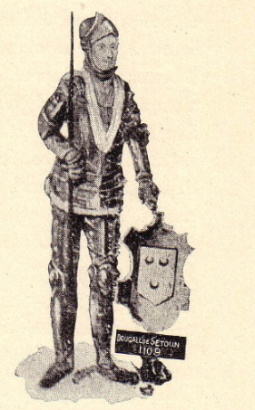 The
son of the 1st Seier de Seton, of de Lens, is known as
Dougall de Setoun and his Christian name was Walter, however he
was usually described by a familiar appellation in the language of
the Scots people around him. He married Janet, daughter of Robert
de Quincy (and not of Roger, who lived a century later) and had a
son also called Seier (2nd) who is often confused with
his grandfather.
The
son of the 1st Seier de Seton, of de Lens, is known as
Dougall de Setoun and his Christian name was Walter, however he
was usually described by a familiar appellation in the language of
the Scots people around him. He married Janet, daughter of Robert
de Quincy (and not of Roger, who lived a century later) and had a
son also called Seier (2nd) who is often confused with
his grandfather.
The Anglo-Flemings wore a strong coat of mail,
which made them objects of dread and wonder to the Britons,
Saxons, Picts and Celts in whose ancient songs they were called Du-gall,
the “Black Strangers”, from the appearance they made when encased
in armor. This name also came from the French “du Gall”, and
referred to the Galois origins where France was once called Gaul.
Dougall de Setoun, then, literally means “the Black Stranger (and
French lord) of the town and lands of Setoun, and he flourished in
the reign of Alexander I., A.D. 1107-1124.
His wife’s father, Robert de Quincy, had
married Maud de St. Liz, daughter of Simon de St. Liz, Earl of
Huntington and Northhampton and Maud, or Matilda, the elder of the
two daughters of Waltheof, Earl of Northumberland and Judith de
Lens, the niece to King William I of England. To appreciate
these ties, note that William married Matilda of Flanders, a
cousin of Dougall. Likewise, Dougall’s grandfather married as his
2nd wife Adele, or Adelaide, of Normandy, William's
sister; it made the Setoun’s cousins of the King and his sons,
William II and Henry I. Henry I married the daughter of Malcolm
III, King of the Scots; and 2nd, Adela of Bas-Lorraine,
a cousin of Count Lambert Lens, Dougall’s grandfather. Malcom
III’s youngest son, later King David I, married Matilda the 2nd
daughter of Waltheof, Earl of Northumberland. Domesday hints
towards the identity of Count Lambert’s sons: In that book are
just their Christian names; Walter and Seier, and it is obvious
from the wording that Seier is absent. Walter, “brother of Seier”,
was still holding lands in 1086 but Seier’s possessions had been
passed to his elder son Walter (or Dougall), described in the
documents as “Walter Flandrensis” – Walter of Flanders, or the
Fleming. He and his
brother Hugh are given as tenants-in-chief of the vast string of
Midlands manors, and the estates in Scotland, Seier had been
granted lands by the Scottish king, Malcolm Canmore.